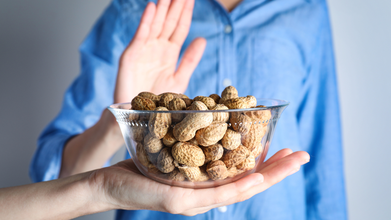- Health Conditions A-Z
- Health & Wellness
- Nutrition
- Fitness
- Health News
- Ayurveda
- Videos
- Medicine A-Z
- Parenting
- Web Stories
Why Do Some Families Keep Having Only Boys or Girls? Science May Finally Have The 'Secret Code'

Credits: Canva
Is the sex of your child really just a coin toss? For generations, we’ve accepted the idea that every pregnancy comes with an even 50-50 shot of producing a boy or a girl. But new research suggests that might not be the full story.
A study published in Science Advances challenges this long-held belief and adds a fascinating new layer to our understanding of human reproduction. Drawing from data spanning nearly 60 years and over 58,000 pregnancies, researchers found compelling evidence that the biological sex of children may sometimes run in families — and that age, genetics, and possibly other overlooked factors could nudge the odds away from that supposedly fair coin flip.
The 50-50 Myth?
At first glance, the logic behind the 50-50 assumption seems solid. Sex in humans is determined primarily by whether the sperm that fertilizes the egg carries an X chromosome (resulting in a girl) or a Y chromosome (resulting in a boy). Since roughly half of a man’s sperm carry each chromosome, it stands to reason that the odds of having a boy or a girl should be equal — right? Not exactly.
Dr. Jorge Chavarro, a reproductive epidemiologist at Harvard T.H. Chan School of Public Health and senior author of the study, wasn’t so sure. Along with PhD student Siwen Wang and a team of collaborators, Chavarro analyzed pregnancy and birth data from the long-running Nurses' Health Study — a landmark series of investigations into women’s health dating back to 1976. They focused on a group of more than 58,000 women who had at least two children.
The team noticed something striking: far more families than expected had multiple children of the same sex — all girls or all boys — especially among women who had their first child later in life. These clusters couldn’t be explained by chance alone.
Also Read: 14-year-old Instagram Influencer Diagnosed With Acute Myeloid Leukemia Passes Away
In other words, some families seemed “tipped” toward having one sex over the other — and the tilt wasn’t always subtle.
Why Age Matters But Not In the Way You Think?
One of the clearest signals in the study was maternal age. Women who had their first child after the age of 28 were about 10% more likely to have all girls or all boys than women who started their families before age 23. It’s a modest but statistically significant increase that held up even after adjusting for various other factors.
It comes down to the biology of reproduction and how it changes over time. As women age, they undergo shifts in the vaginal environment and reproductive hormones that could influence which sperm — X or Y — are more likely to reach and fertilize the egg. For instance:
The vaginal environment may become more acidic with age, and X-carrying sperm (which are slightly larger and more chemically robust) may survive better in such conditions.
The first phase of the menstrual cycle, called the follicular phase, tends to shorten with age. Some researchers believe this could create changes in cervical mucus and oviduct fluid that favor Y sperm instead.
These competing factors mean the impact of aging on sex outcome may not be uniform — it could vary depending on individual biology. But the net result is that older maternal age seems to increase the odds of having children all of the same sex.
Another eye-opening part of the study was its genetic analysis. Researchers examined genetic data from a subset of over 7,500 women and found two specific gene variants that were significantly associated with single-sex offspring.
One gene variant (located near NSUN6) was linked to having all daughters.
Another (near TSHZ1) was associated with having all sons.
These genes aren’t currently known to affect fertility or reproduction directly, and their exact roles remain unclear. But their presence suggests a biological basis for sex-skewed births in some families — an area ripe for future research.
In short, while we’ve long believed sex determination is a random roll of the dice, some people might have a “weighted coin” — without ever realizing it.
Could Behavior Be Driving the Pattern?
Some might wonder: what if this pattern is just driven by behavior? For instance, parents who have two boys might keep trying until they have a girl, leading to more same-sex siblings by default. The researchers considered this too.
To rule out this explanation, they ran an analysis excluding the last birth in each family — the one most likely to be affected by the decision to stop having more children after getting “one of each.” Even then, the same-sex clustering held strong.
That suggests something deeper is going on, rooted in biology rather than just human choice.
What This Means for Expecting Parents?
So, what should couples take away from this? First, there’s no need to overthink your chances if you’re planning to start a family. Across the entire population, the average likelihood of having a boy or a girl still hovers close to 50%. But for some individual families, those odds may be subtly skewed by age, genetics, and biological quirks we’re only beginning to understand.
Importantly, the study also highlights just how much we still don’t know about sex determination and human reproduction. It opens new avenues for exploring how maternal and paternal factors interact — and how genetic and environmental forces shape outcomes in subtle but meaningful ways.
Also Read: What Is Jess's Rule? How A Missed Cancer Diagnosis Led To A New Rule For General Practitioners
Wang and her team hope to replicate the findings in more diverse populations and include paternal data in future analyses. Since most participants in this study were white and from the U.S., it’s not yet clear how these patterns hold across other racial, ethnic, and geographic groups.
This research doesn’t rewrite the biology of reproduction — but it does suggest that some old assumptions might be oversimplified. Sex may still be determined by the X or Y chromosome in sperm, but the journey to conception is influenced by a dynamic, personal landscape of biological factors.
What the study captures is a new lens: a shift away from the purely statistical view of childbirth toward a more personalized understanding of how life begins.
And perhaps, for families that have always wondered why they have “just boys” or “just girls,” the answer might be: it’s not just chance. It might be part of your biological story written long before the baby arrives.
Parenting Habits That Creates Struggling Adults, According To Child Psychologist

Credits: Canva
Raising a child is not the easiest job. In fact, everyday feels like a new test. Somedays you would find yourself jumping to finish cleaning your child's toys even when you asked them to do. On other days, you would have a meltdown, but will have to manage to stop it.
But while you do all of these, there may be certain actions that may make your child into a struggling adult.
Child psychologist, and professor Daniel J Moran, of Touro University New York, told Newsweek, "Parents...are working overtime to make their children's lives smooth and happy. The intention is love, [but[ the outcome is often dependency."
This happens when parents remove discomfort from a child's life. The above example of the parent picking up child's toys is one such instance. If one has to apply science into it, children learn confidence by experiencing consequences and discovering that they can handle it. If parents get everything done for them, they will never know if they could handle a certain situation.
Moran says that true resilience comes from "hearing to stay present, feel the hard stuff and keep moving toward what matters."
Three Common Habits And Actions Of Parents That Could Take Away Their Child's Independence And Make Them A Struggling Adult
Fix Instead of Coach: This happens when parents jump in to solve every problem on their own. This teaches the kids that they do not have to work things on their own. Instead of fixing, parents must coach their kids, guide them into solving things.
Overpraising: While appreciating one's effort, especially when a child does something big for the first time is important. However, continuously praising your child on a day to day basis, without having to achieve something new or special could remove the learning value of effort and feedback. For every activity that a child does, praise is not the only feedback, it could also be critical in nature.
Overscheduling: Parents often feel the urge to teach their child everything, especially the things they wanted to learn as kids, but never got to. However, it leaves little room for boredom, which is dangerous, as Moran says that boredom is a place, "where creativity and self direction grow".
So, What Can Parents Do?
Moran says that the parents should let their kids "struggle safely". Parents can also model questions of acceptance of mistakes and ask reflective questions, such as "who do you want to be right now?"
"If we want confident, capable young adults, we have to let kids practice being uncomfortable,” Moran says. "Confidence doesn’t come from constant praise, but comes from persistence, problem-solving and purpose. A little discomfort today can build the psychological flexibility they’ll need tomorrow.”
Dr Samantha Whiten, clinical psychologist, owner of Best Life Behavioral Health tells Newsweek that overhelping often encourages overdependence. " Doing everything for your child when they can physically do things for themselves... trains them to depend on you for everything versus being proud and confident in what they can master on their own,” she says.
So Whiten recommends a steady approach that can build confidence. The first step is to demonstrate the task and let the child try it while you observe. Then leave the room, observe from afar, because you leaving the room would mean that you are confident in your child.
Fewer Children Are Now Allergic To Peanuts, Study Reveals The Key To Lesser Allergies In Kids

(Credit-Canva)
Allergies are common, and anyone can develop them at any age. An allergy is an immune response that occurs when the body mistakes a harmless substance for a threat.. This then causes your body to overreact, leading to symptoms that range from mild to life threatening. One of the most common allergens is peanuts. However, recent studies have shown that there is a way we can lower the risk of developing this allergy.
A new study has found that food allergies in young children have fallen sharply since 2017, when the guidelines for introducing common allergens into the child’s diet were changed.
For many years, experts advised parents to avoid giving common allergens to their babies because allergy rates were climbing. However, a major study in 2015 discovered that feeding peanuts to infants could slash their risk of developing a peanut allergy by over 80%. Based on this finding, the National Institute of Allergy and Infectious Diseases issued official guidelines in 2017 recommending this early-introduction approach.
How Much Did Peanut Allergy Cases Go Down?
The study, published in the journal Pediatrics, analyzed food allergy rates in children under the age of three before and after the 2017 guidelines were issued. The results showed a significant decline:
- Overall food allergies dropped to 0.93% between 2017 and 2020, down from 1.46% between 2012 and 2015.
- This represents a 36% reduction in all food allergies.
- The decline was mainly driven by a huge 43% drop in peanut allergies.
- The study noted that eggs have now taken over peanuts as the most common food allergen in young children.
Can People Outgrow Allergies?
While the study didn't directly track what infants were fed, the data is highly encouraging because the drop in allergies happened right after the new guidelines were put into effect.
While the results are highly encouraging, the study noted that many doctors and parents still haven't fully adopted the new advice. Surveys show that full compliance remains low among both pediatricians and caregivers.
The study also found shifts in the racial and ethnic breakdown of children diagnosed with food allergies. Compared to the pre-guidelines period, there were fewer food-allergic children who were Black, Asian or Pacific Islander, and Hispanic in the post-guidelines period, with an increased proportion of White children. The researchers noted that these changes might reflect differences in how easily different groups can access healthcare and information about the new feeding practices.
Experts see this as a major public health success. Experts see this as a major public health success, noting that the data provide real-world evidence of how a simple public health recommendation can improve children’s health. This is particularly important for peanut allergies, which 80% of people never outgrow and can be life-threatening.
While the reasons for food allergies are still not completely understood, some scientists believe factors like higher rates of C-section births, early use of antibiotics, and increasingly sanitized environments may still play a role. However, the data suggests that early introduction is a powerful tool to protect children.
Stacey Hatfield, Australian Food Influencer, Dies Of A Rare Pregnancy Complication

Credits: GoFundMe
While most pregnancies normally and do not have any serious complications, notes Johns Hopkins Medicine, sometimes rare complications can occur and it can then interfere with normal fetal development. In such a case, Australian nutritionist and social media influencer Stacey Hatfield tragically passed away. Her husband described it as an “extremely rare complication” during childbirth. The 30-year-old Melbourne native was known for promoting toxin-free living and wholesome recipes under the handle @naturalspoonfuls, where she had more than 17,000 followers.
Hatfield’s pregnancy had been filled with joy and anticipation. She and her husband, Nathan Warnecke, were just two months away from celebrating their first wedding anniversary when she went into labour at home on September 29.
She gave birth to a healthy baby boy, Axel, fulfilling what Warnecke said was her “biggest dream in life — to be a mum.” But moments after delivering her son, the “unimaginable” occurred.
A Tragic Turn After Birth
According to Warnecke, Hatfield developed an “unforeseen and extremely rare complication” immediately after childbirth. She was rushed to the hospital, where medical staff did everything they could to save her life.
“Hospital staff were amazing and did the utmost to help, but ultimately nothing could be done despite their best efforts,” Warnecke said in a social media post announcing her passing. “Words can’t do justice to how devastating this is for myself and everyone that knew and loved her.”
He shared that Hatfield’s final moments were filled with love and happiness as she held her newborn son in her arms. “She held Axel when he was born, nursed him, saw that he was a boy, and loved him,” he wrote. “She loved him so much and still continues to love him.”
Remembering a “Lighthouse in the Storm”
Warnecke, who called Stacey his “beautiful wife, soulmate, and best friend,” said her passing has left a void that words cannot fill. “I knew Stace for nine amazing years — she was the light of my life and the reason I got up in the morning,” he said. “She was my lighthouse in the storm, and the world is less bright without her in it.”
He described her as “the most beautiful, loving, caring, hardworking, disciplined, intelligent, and trustworthy human being” he had ever known.
Community Support for the Family
In the wake of the tragedy, family, friends, and the wider community have come together to support Warnecke and baby Axel. A GoFundMe page has raised more than $20,000 to help cover funeral expenses, childcare, and household costs as the grieving family adjusts to life without Stacey.
What Are Some Of The Rarest Pregnancy Complications That Can Kill The Mother?
- Lower Urinary Tract Obstruction: a rare fatal condition that occurs when there is a blockage in the urinary tract of a developing fetus. In this condition, the urine cannot be drained, and the fluid around the fetus decreases.
- Amniotic Fluid Embolism: this is when amniotic fluid, cells, hair, or fecal matter of the baby enters the mother's blood circulation and leads to conditions like Disseminated Intravascular Coagulation (DIC).
- Pulmonary Embolism: this happens when the blood in mother becomes more coagulable and could sometimes form blood clots, known as thrombosis.
- Uterine Rupture: it is a rare complication, where the risk of it happening is less than 1%. If it occurs, it usually happens during labor.
© 2024 Bennett, Coleman & Company Limited

